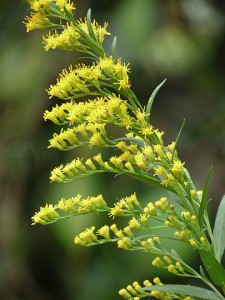Pinellas County’s Preserves are a great place to see our amazing wildflowers in their natural ecosystems. Autumn brings a flush of late-flowering plants; whose fruits and seeds may provide food for wildlife through the winter months. The drive out to Weedon Island Preserve in St. Petersburg is bordered on both sides by long swathes of flowering Spotted Beebalm or Horsemint (Monarda punctata). This mint relative has tiers of spotted creamy-white flowers, subtended by showy pink bracts. This plant is visited by a host of pollinators, which can be seen busily buzzing from flower to flower. From clumsy bumblebees to some of our smallest native bees, brightly colored and bottle green, these plants provide a nectar reward to the pollinators in exchange for the transfer of pollen from one plant to another. Don’t be afraid if you’d like to stop and watch the pollinators busy at work. They’ve got a job to do, and as long as you keep a respectful distance (no touching!) the bees, wasps and other pollinators will keep to themselves. In addition to our native pollinators, the introduced European Honeybee (Apis melifera) can also be found amongst the busy throng.

At Brooker Creek Preserve in Tarpon Springs things are about to get very pink and gold. Chaffhead (Carphephorus spp) is beginning to stretch its inflorescences skyward. These will open into either flat-topped or rounded heads of pale violet flowers. Several species of these plants can be found in the flatwoods ecosystem. Flowering alongside may be several species of Goldenrod (Solidago spp.). Goldenrod has a reputation for causing hayfever, but it is actually another late-flowering plant, Ragweed (Ambrosia artemisiifolia) that causes those symptoms. Ragwed has hundreds of very small, green flowers that are easily overlooked, unlike the showy, yellow-flowered Goldenrod. Ragweed’s tiny flowers produce pollen that is transported by the wind. Therefore, with all that pollen in the air, we are likely to inhale some and our nasal passages become irritated.
![By Bob Peterson from North Palm Beach, Florida, Planet Earth! [CC BY-SA 2.0 (http://creativecommons.org/licenses/by-sa/2.0)], via Wikimedia Commons Florida_paintbrush_(Carphephorus_corymbosus)_(6256923212)](https://blogs.ifas.ufl.edu/pinellasco/files/2015/09/Florida_paintbrush_Carphephorus_corymbosus_6256923212-300x300.jpg)


Another green flower that is just starting its long flowering season is our native Rein Orchid (Habenaria floribunda). This is a plant of moist, shady places like bottomland forests and cypress swamps. After lying dormant throughout the summer, this terrestrial (ground-dwelling) orchid produces pale green strap-shaped leaves in a tight rosette on the forest floor. In a month’s time, the flowering stalk will appear, bearing up to a dozen green orchid flowers. The strap-shaped petals give this plant its scientific and common name, Rein Orchid. “Habena” is a Greek word for the reins of a horse’s tack.

There are many more wonderful wildflowers getting ready to transform our native ecosystems. On October 17th you can enjoy a Festival of Wildflowers at Brooker Creek Preserve. Wander through a butterfly tent with 250 butterflies, see live honeybees hard at work, learn about wildflowers through a variety of presentations, brave the scavenger hunt on the hiking trails and enhance your own yard with wildflowers available for sale! A special craft area for children will be featured as well. Don’t miss out on this fun, free, family event!
 0
0
